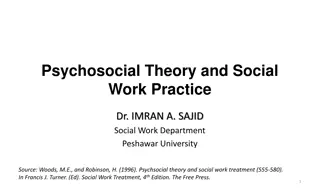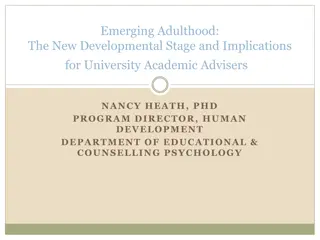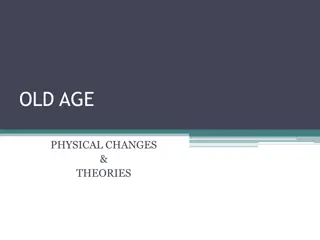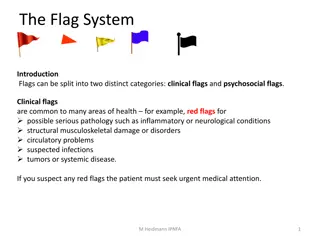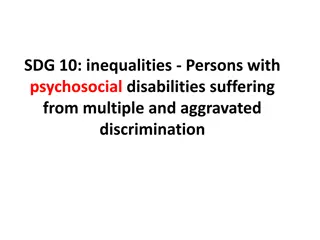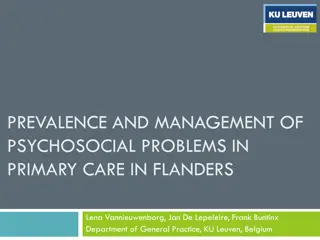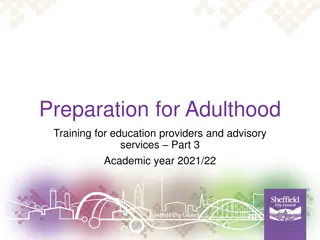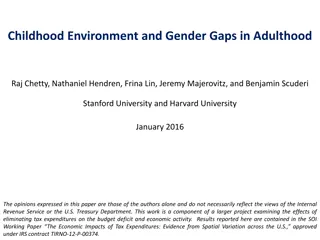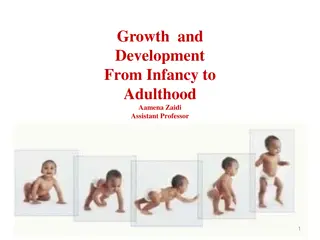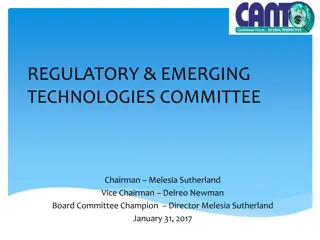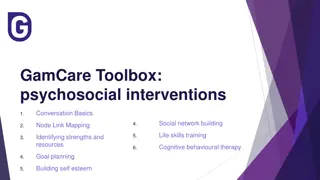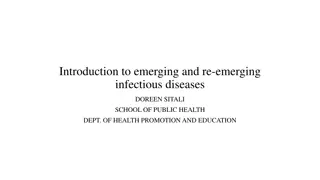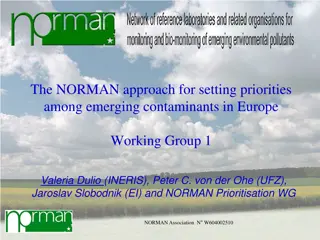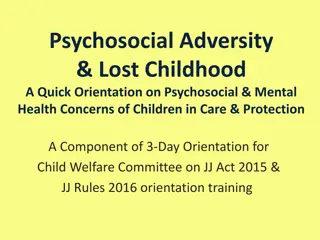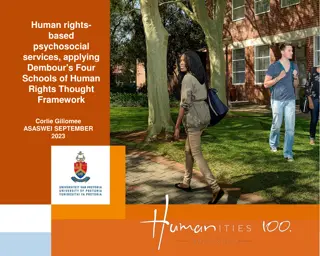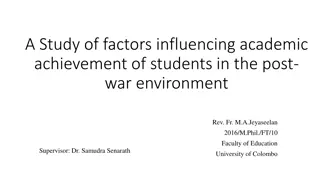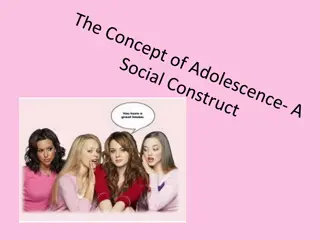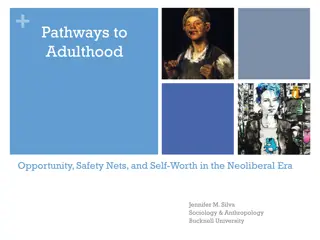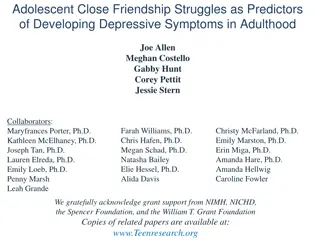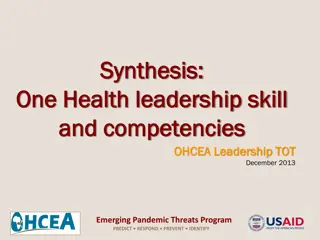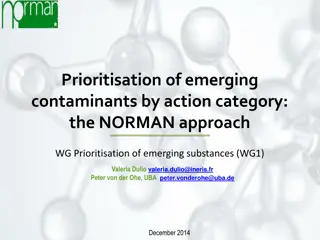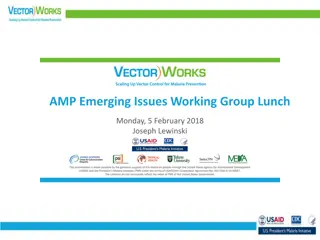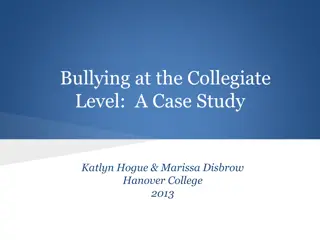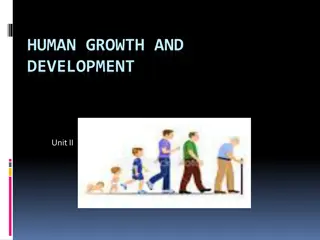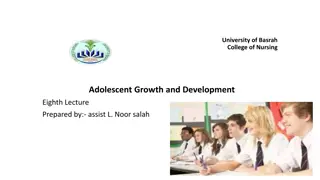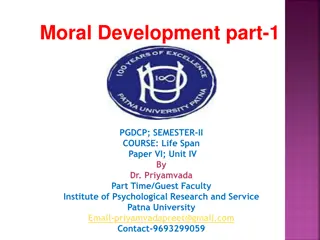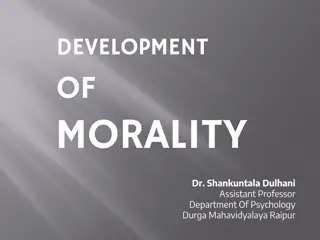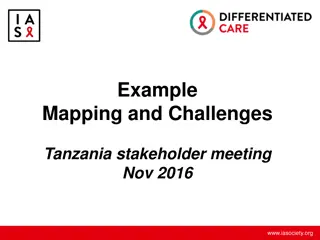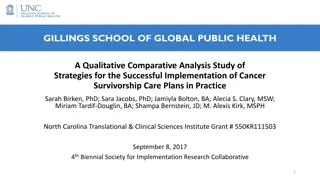Insights on Emerging Adulthood and Psychosocial Development
Delve into the unique stage of emerging adulthood, spanning ages 18-25, characterized by factors like delayed marriage, higher education pursuits, and vocational instability. Explore themes of homeostasis, risk-taking behavior, psychopathology risks, and Erik Erikson's stage of Intimacy vs. Isolation. This period signifies a crucial juncture in the biosocial, cognitive, and psychosocial development of individuals experiencing the transition to adulthood.
Download Presentation

Please find below an Image/Link to download the presentation.
The content on the website is provided AS IS for your information and personal use only. It may not be sold, licensed, or shared on other websites without obtaining consent from the author. Download presentation by click this link. If you encounter any issues during the download, it is possible that the publisher has removed the file from their server.
E N D
Presentation Transcript
Chapter Seventeen, Eighteen and Nineteen Emerging Adulthood: Biosocial, Cognitive and Psychosocial Development
Emerging Adulthood Emerging Adulthood is a new stage of development in the lifespan the occurs between the ages of 18-25 because of globalization, technology, and medicine. The reasons for the emerging adulthood stage is that people are marrying later, the need for higher education, prolonged financial dependence, and vocational instability.
Homeostasis Homeostasis is the body s natural adjustment to any disruptions. Homeostasis keeps the body healthy by maintaining equilibrium. The set point is an example of homeostasis. Homeostasis is quick an efficient during emerging adulthood, which is the major reason why young adults are less likely to be sick, fatigued, or obese than older adults. Homeostasis keeps sex drive or the sexual reproductive system healthy. Emerging adults are serial monogamists. They date and have sex and date and have sex. This culture is quite different than it was fifty years ago.
Emerging Adults and Taking Risks Emerging Adulthood is marked by a greater willingness to take risks, of all sorts, not just sexual ones. Edgework are occupations, recreational activities, or other ventures that involve living on the edge, managing stress and fear. Emerging Adults are likely to engage in Edgework.
Psychopathology Psychopathology is also know as mental disorders . The Diathesis-Stress Model is the view that psychopathology is produced by the interaction of genetic vulnerability and stressful environmental factors. Substance abuse disorders, mood disorders, anxiety disorders, and schizophrenia are more likely to appear in emerging adulthood. Untreated disorders is one reason why suicide is higher in emerging adulthood than adolescence.
Erik Eriksons Theory of Psychosocial Development Stage Five Stage: Intimacy vs. Isolation Ages: 18-40 Psychosocial Conflict: Young Adults seek intimacy. Intimacy is a close connection with another human being. Intimacy is mutual and not self-absorbed, which means adults need to devote time and energy to one another. If an individual does not develop intimate relationships, they will become isolated from other human beings. Erikson identified that in order to develop an intimate relationship with another human being that and individual must have found their IDENTITY.
Robert Sternbergs Triangular Theory of Seven Types of Love There are three components to Robert Sternberg s triangular theory of love intimacy, passion, and commitment. In regards to intimacy, there are many elements such as bonding, connectedness, feelings of closeness, admiration, and feelings of wanting to take care of one another. Passion is more defined by the inert drives towards one another that often results in intensity of love for one another. Commitment is the component that results when both parties decide they love each other and are wishing to maintain that love and relationship long term.
Chapter Twenty and Twenty-One Adulthood: Biosocial and Cognitive Development
Adulthood Young Adulthood is the developmental stage between ages 25-40. Middle Adulthood is the developmental stage between the ages of 40-65. The four decades of adulthood are from 25-65.
The Aging Process Senescence is the gradual physical decline that is related to aging and during in which the body becomes less strong and efficient. Senescence or the first signs of aging can be seen in the skin. Aging also affects the sense organs and the sexual reproductive system
Problems with the Sexual-Reproductive System in Adulthood Sexual Responsiveness decreases with aging. For some couples, it may be because of reduced anxiety and better communication. Distress and slower responsiveness is associated with anxiety and interpersonal relationships than aging. Fertility Issues are caused by infertility among men and women. Due to changes in social standards, couples are waiting to start a family. These individuals often have a hard time conceiving. They may turn to alternative methods, such as IVF (in vitro fertilization). Menopause is the cessation of the menstrual cycle for women and a reduction in the hormone estrogen. Men also go through a type of menopause as they grow older due to a reduction of the hormone testosterone. This type of menopause is called Andropause. These may also contribute to a lack of interest in sexual activity.
Poor Health Habits and Senescence Drug Use Tobacco Overeating Inactivity
Measuring Health Mortality is a measure of health based on the number of deaths per year of a given population. It is the most accurate measure of health. Morbidity is a measure of health which refers to diseases of all kinds- physical, emotional, acute (sudden) and chronic (ongoing) in a given population. Disability is a measure of health which refers to long- term difficulty performing normal activities of daily life due to some physical, emotional, or mental condition. Vitality is a measure of health that refers to how healthy and energetic a person feels.
Research on Age and Intelligence Intelligence can be defined as the 1) capacity for learning, reasoning, understanding, and similar forms of mental activity 2) aptitude in grasping truths, relationships, facts, and meanings 3) manifestation of a high mental capacity and 4) knowledge of an event or circumstance. Researchers on Intelligence in the 20thcentury believed that intelligence is something some people have and some people do not, because some people are smarter then others.
Research on Age and Intelligence Charles Spearman (1927) proposed a theory that there is a single entity called General Intelligence, which he called g . Spearman concluded in his theory that intelligence cannot be measured directly, it can be evaluated from various abilities; vocabulary, memory, and reasoning. A person therefore could be assigned an overall IQ score, based on standardized tests of intelligence. The overall score would indicate whether a person was a genius, average or retarded.
Research on Age and Intelligence In the 1980s, scholar James R. Flynn published research noting that IQ scores increase from generation to generation in every country that uses the test. Children have higher scores -- between 5 and 25 points higher -- than their parents. This observation has become known as The Flynn Effect , and while researchers agree that it happens, they don't know why it happens. The Seattle Longitudinal Study (1956-2005) found many cohort differences in IQ scores as societies change their emphasis on various intellectual skills. Overall, the study found that people improve most in mental abilities during adulthood.
Research on Age and Intelligence Raymond Cattel and John Horn (1960 s) studied the results of intelligence tests. The concluded that adult intelligence is best understood in two categories. These two categories are fluid and crystallized intelligence. Fluid Intelligence is basic mental abilities, such as; inductive reason, abstract analysis, reaction speed, and working memory. Crystallized Intelligence is the accumulation of facts, information, and knowledge as a result of experience. The size of one s vocabulary, the knowledge of chemical formulas, and long-term memory for dates in history are all examples of crystallized intelligence.
Research on Age and Intelligence Robert Sternberg s Three Distinct types of Intelligence Theory (1988-2006) proposed that each of these intelligences serves a different purpose in terms of circumstances. Creative Intelligence is prized as individuals get older because we tend to engage in activities that challenge us and that we enjoy. Academic- measured by I.Q. and achievement tests. The mastery in skills, body of knowledge or specific topics. The mastery in skills, body of knowledge, or specific topics. Creative- is activated through processes of intention and attention. When we become aware of these processes, we can learn how to apply them. It is fostered through understanding how the creative process works in human beings and how to apply it. Practical - involves the ability to grasp, understand and deal with everyday tasks. It reflects how the individual relates to the external world about him or her. This is what is known as street smarts .
Research on Age and Intelligence Howard Gardner s Nine Cluster Multiple Intelligence Theory (1983-2006) propose that these differences "challenge an educational system that assumes that everyone can learn the same materials in the same way and that a uniform, universal measure suffices to test student learning. Indeed, as currently constituted, our educational system is heavily biased toward linguistic modes of instruction and assessment and, to a somewhat lesser degree, toward logical-quantitative modes as well." Gardner argues that "a contrasting set of assumptions is more likely to be educationally effective. Students learn in ways that are identifiably distinctive. The broad spectrum of students - and perhaps the society as a whole - would be better served if disciplines could be presented in a numbers of ways and learning could be assessed through a variety of means."
Howard Gardners Nine Intelligences Linguistic Logical-mathematical Musical Spatial Bodily-kinesthetic Naturalistic Social Understanding (Interpersonal) Self Understanding (Intrapersonal) Existential
Chapter Twenty-Two Adulthood: Psychosocial Development
Abraham Maslow (1908-1970) Abraham Maslow Abraham Maslow grew up in Brooklyn, New York, the first of seven children born to his Jewish parents who emigrated from Russia. Maslow later described his early childhood as unhappy and lonely, and he spent much of his time in the library immersed in books. He attended the University of Wisconsin where he developed an interested in psychology and found a mentor in psychologist Harry Harlow who served as his doctoral advisor. Maslow earned all three of his psychology degrees from the University of Wisconsin and received his Ph . D in 1934. During the 1950s, Maslow became one of the founders and driving forces behind the school of thought known as humanistic psychology. His theories including the hierarchy of needs, self-actualization and peak experiences became fundamental subjects in the humanist movement.
Carl Rogers (1902-1987) Carl Rogers was a humanistic psychologist who agreed with the main assumptions of Abraham Maslow, but added that for a person to "grow", they need an environment that provides them with genuineness (openness and self- disclosure), acceptance (being seen with unconditional positive regard), and empathy (being listened to and understood). Without these, relationships and healthy personalities will not develop as they should, much like a tree will not grow without sunlight and water. Rogers believed that every person can achieve their goals, wishes and desires in life. When, or rather if they did so, self actualization took place. This was one of Carl Rogers most important contributions to psychology and for a person to reach their potential a number of factors must be satisfied.
Humanistic Psychology Humanistic, humanism and humanist are terms in psychology relating to an approach which studies the whole person, and the uniqueness of each individual. Essentially, these terms refer the same approach in psychology. Humanism is a psychological approach that emphasizes the study of the whole person. Humanistic psychologists look at human behavior not only through the eyes of the observer, but through the eyes of the person doing the behaving. Humanistic psychologists believe that an individual's behavior is connected to their inner feelings and self concept. The humanistic approach is thus often called the third force in psychology after psychoanalysis and behaviorism (Maslow, 1968).
Humanistic Psychology Humanistic psychology begins with the existential assumptions that phenomenology is central and that people have free will. Personal agency is the humanistic term for the exercise of free will. Personal agency refers to the choices we make in life, the paths we go down and their consequences. A further assumption is then added - people are basically good, and have an innate need to make themselves and the world better. The humanistic approach emphasizes the personal worth of the individual, the centrality of human values, and the creative, active nature of human beings. The approach is optimistic and focuses on noble human capacity to overcome hardship, pain and despair.
Self- Actualization in Humanistic Psychology What a man can be, he must be. This need we may call self-actualization It refers to the desire for self- fulfillment, namely, to the tendency for him to become actualized in what he is potentially. This tendency might be phrased as the desire to become more and more what one is, to become everything that one is capable of becoming. - Abraham Maslow Self- Actualization is to realize fully one's potential .
Characteristics of Self-Actualized People In addition to describing what is meant by self-actualization in his theory, Maslow also identified some of the key characteristics of self- actualized people: Acceptance and Realism: Self-actualized people have realistic perceptions of themselves, others and the world around them. Problem-centering: Self-actualized individuals are concerned with solving problems outside of themselves, including helping others and finding solutions to problems in the external world. These people are often motivated by a sense of personal responsibility and ethics. Spontaneity:Self-actualized people are spontaneous in their internal thoughts and outward behavior. While they can conform to rules and social expectations, they also tend to be open and unconventional.
Characteristics of Self-Actualized People Autonomy and Solitude: Another characteristic of self-actualized people is the need for independence and privacy. While they enjoy the company of others, these individuals need time to focus on developing their own individual potential. Continued Freshness of Appreciation:Self-actualized people tend to view the world with a continual sense of appreciation, wonder and awe. Even simple experiences continue to be a source of inspiration and pleasure. Peak Experiences are individuals who are self-actualized often have what Maslow termed peak experiences, or moments of intense joy, wonder, awe and ecstasy. After these experiences, people feel inspired, strengthened, renewed or transformed.
Carl Rogers Personality Theory Carl Rogers believes that congruence and incongruence is the important ideas of psychology. With looking at congruence Rogers believes that it is the drive to become what one can be, to raise your own potential. For this you also need for positive regard. A congruent person is genuine, which also leads to falseness and then eventually not releasing full potential. Congruent people will live lives that are not true to themselves. Incongruent people are defensive, and being this leads to eventually the malfunctioning of the person. Self-Concept is a general term used to refer to how someone thinks about or perceives themselves. The self concept is how we think about and evaluate ourselves. To be aware of oneself is to have a concept of oneself. Self Concept is an important term for both social psychology and humanism.
Carl Rogers Personality Theory Congruent Incongruent Ideal Self Ideal Self Self- Concept Self- Concept
Erik Eriksons Theory of Psychosocial Development Stage Seven: Generativity vs. Stagnation Ages: 40-65 Psychosocial Conflict: Adults need to take care of the next generation, by raising their own children or by mentoring, teaching, and helping the younger generation. If they do not have an identity or intimate relationships with others, they will become self- absorbed and stagnate.
The Five-Factor Theory of Personality The Five Factor Theory was first introduced by McCrae and Costa (1984) and is based on the assumption that personality is relatively stable in adulthood. Generally, the traits that we show at the age of 30 would remain essentially unchanged into old age. (McCrae & Costa, Personality in Adulthood) Therefore, assessing personality based on the core traits what will not change through adult life seemed like a reliable method. There have been a lot of multi-cultural, cross-sectional and longitudinal studies throughout the past two decades. All of this research has confirmed the reliability and validity in the NEO Personality Inventory, or NEO-PI (Costa & McCrae, 1985, 1989) and has postulated there are indeed universal personality traits that characterize people all over the world. Based on this extensive research and years of observing and interviewing people, McCrae and Costa identified the five core traits what describe a personality: Neuroticism, Extraversion, Openness (to experience), Agreeableness and Conscientiousness. These are the basic dispositions that endure through adulthood and shape our behavior and lives.
The Five-Factor Theory of Personality Openness to Experience Down-to-earth- Imaginative Uncreative Creative Conventional Original Prefer routine Prefer variety Uncurious Curious Conservative Liberal
The Five-Factor Theory of Personality Conscientiousness Negligent- Conscientiousness Lazy- Hardworking Disorganized- Well-organized Aimless- Ambitious Quitting- Persevering
The Five-Factor Theory of Personality Extraversion Reserved Affectionate Loner Joiner Quiet Talkative Passive Active Sober Fun-loving Unfeeling Passionate
The Five-Factor Theory of Personality Agreeableness Ruthless Softhearted Suspicious Trusting Stingy Generous Antagonistic Acquiescent Critical Lenient Irritable Good-natured
The Five-Factor Theory of Personality Neuroticism Calm Worrying Even-tempered Temperamental Self-satisfied Self-pitying Comfortable Self-conscious Unemotional Emotional Hardy Vulnerable


